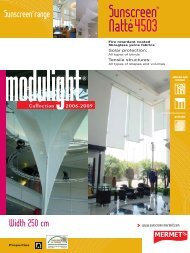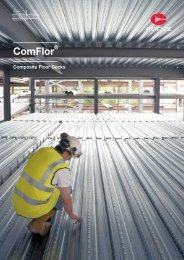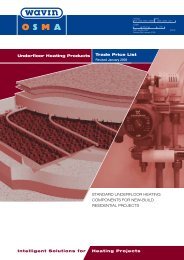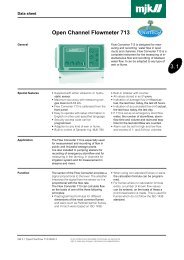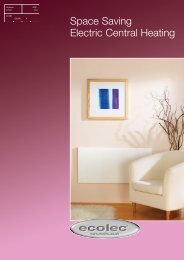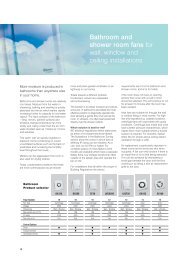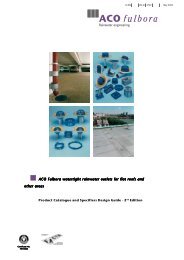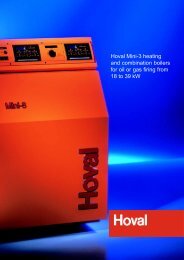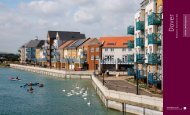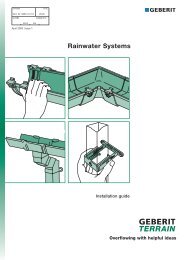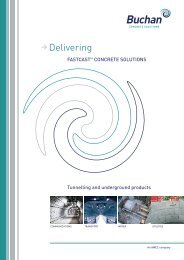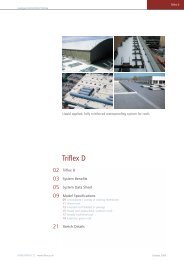Imax condensing boilers - CMS
Imax condensing boilers - CMS
Imax condensing boilers - CMS
You also want an ePaper? Increase the reach of your titles
YUMPU automatically turns print PDFs into web optimized ePapers that Google loves.
12<br />
flueing<br />
Flue Systems<br />
To ensure safe and satisfactory operation, the boiler must be<br />
connected to a chimney system capable at all times of adequately<br />
evacuating the combustion products (see performance data table on<br />
page 14 for approximate volumes).<br />
The Ideal W & Plus <strong>boilers</strong> are suitable for use in<br />
both room sealed and open flue fan assisted operation. Connections<br />
for combustion air inlet and flue products discharge are located on<br />
the top of the appliance ( Plus: separate vertical flue outlet to<br />
left, right or rear, air inlet at left or right).<br />
concentric and<br />
twin duct systems<br />
The jacket of the Ideal <strong>condensing</strong> boiler is constructed<br />
such that it forms an air tight seal. It is therefore important that the<br />
jacket of the unit is fitted properly whilst the boiler is in operation.<br />
The boiler is suitable for use in either single or multiple flue<br />
configurations and can be fitted with a wide variety of flue systems.<br />
Horizontal flue runs MUST be inclined at 2.5˚ to the horizontal<br />
in order that any condensate formed can be discharged through the<br />
boiler.<br />
W Flue Kits<br />
W Only<br />
The flue kits are suitable for use with the Ideal boiler only.<br />
These kits and the associated options are suitable for both roof<br />
and wall mounting applications.<br />
Several flue options are available:<br />
• Horizontal flue kits (80/125mm or 100/150mm dia.)<br />
• Vertical roof flue kits (80/125mm or 100/150mm dia.)<br />
• Twin pipe flue kits<br />
• Open flue kits<br />
The twin pipe flue kit is suitable where particularly long flue<br />
runs are required and compact flue and air ducts are required.<br />
The roof kit is suitable for both flat and pitched roof termination,<br />
using a concentric flue (tube within tube) to run vertically from the<br />
top of the boiler and terminating above the roof level.<br />
If obstructions prevent direct flue routing then both 90˚ and 45˚<br />
elbows can be provided to offset any of the flue systems.<br />
Accessories<br />
Flue duct extension kits are available for flue lengths extending<br />
beyond 1 metre. These packs contain additional 1 metre ducts and<br />
may be cut to the desired length.<br />
Elbows, 90˚ and 45˚, are also available.<br />
W & Plus<br />
All joints or connections in the flue system must be impervious<br />
to condensate leakage and also any low points in the flue system<br />
should be drained using pipe of material resistant to condensate<br />
corrosion.<br />
The flue duct termination point must be positioned so that it will<br />
not be affected by adverse wind conditions and be free from any<br />
obstructions. Note: A vapour plume will be visible at the terminal.<br />
Therefore where possible terminal positions which could cause<br />
problems due to plumeing should be avoided.<br />
The use of a fan on the boiler permits long flue runs however,<br />
the resistance of bends etc will reduce the overall length. Full details<br />
of the W flue sizes and resistances can be found on page 13<br />
of this booklet.<br />
NO additional diverter, stabiliser, or draught break should be<br />
installed in the chimney system without prior consultation with<br />
Caradon Ideal Ltd.<br />
Flues and terminal positions should be designed with strict<br />
regard to the requirements of BS 5440: Part 1, BS 6644, IGE<br />
UP/10 and the Building Regulations Part J as appropriate. Particular<br />
attention should be paid to these for multiple boiler installations and<br />
if required, the Clean Air Act.<br />
Weatherproofing<br />
Where the flue passes through the roof line an adequate seal<br />
must be made. This can be achieved by using either:<br />
• Flat weather collar 125mm or 150mm<br />
• Pitched weather collar 125mm or 150mm<br />
Additional information covering selection and installation can be<br />
found within this guide.



